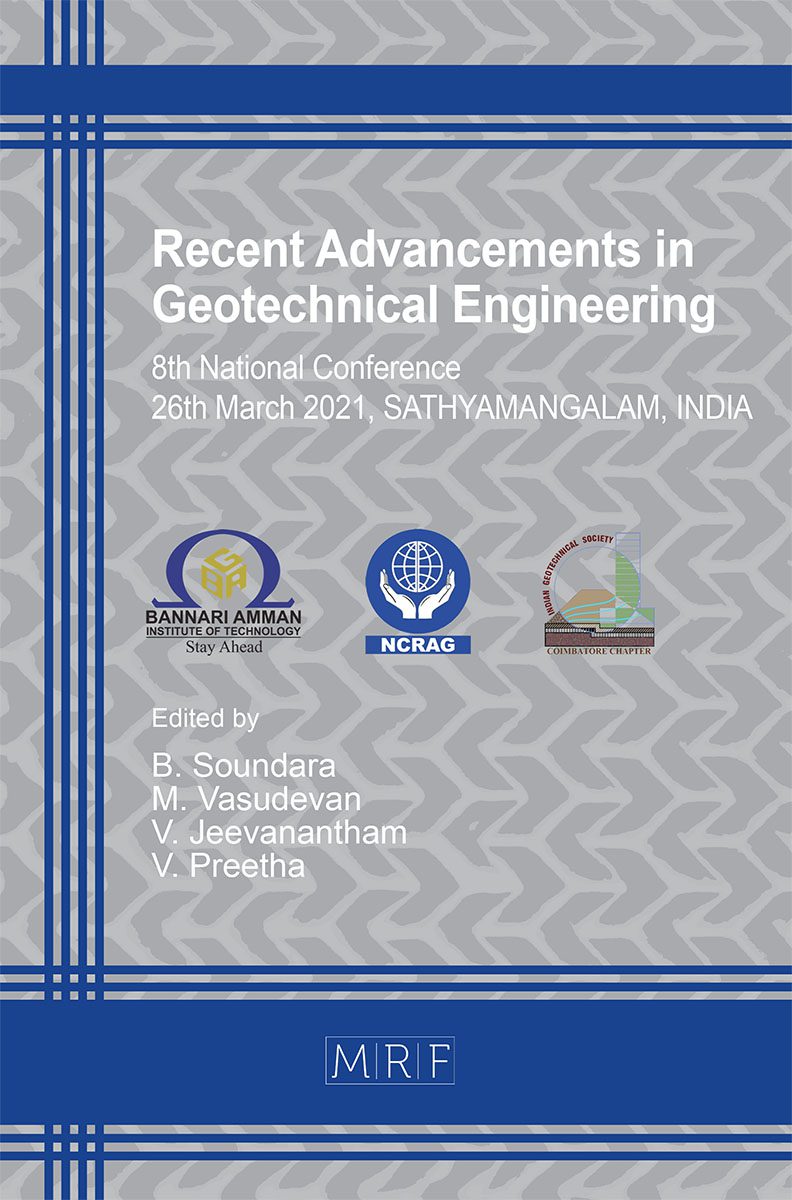Stabilization of Black Cotton Soil with Groundnut Shell Ash
R. Premkumar, B. Subha, S. Pattu Sandhiya, K. Shankar Narayanan
download PDFAbstract. The analysis of GSA for the stabilization of soil samples is the subject of this research paper. In recent years, soil stabilization techniques have been effective in improving the shear strength parameters of poor soils. GSA is a naturally occurring substance that causes human health and environmental issues. Physical properties of soil were calculated, including Atterberg’s limits, compaction characteristics, and strength characteristics of virgin soil samples. GSA was applied to the soil in various percentages (2 to 10 percent). The soil sample’s intensity increased up to 6% before decreasing. It is clear that 6% of GSA to the soil is an optimum percentage and it leads to an increase in shear strength and bearing capacity in expansive soil.
Keywords
California Bearing Ratio (CBR), Unconfined Compressive Strength (UCS), Stabilization, Groundnut Shell Ash (GSA), Black Cotton Soil
Published online 8/15/2021, 7 pages
Copyright © 2021 by the author(s)
Published under license by Materials Research Forum LLC., Millersville PA, USA
Citation: R. Premkumar, B. Subha, S. Pattu Sandhiya, K. Shankar Narayanan, Stabilization of Black Cotton Soil with Groundnut Shell Ash, Materials Research Proceedings, Vol. 19, pp 44-50, 2021
DOI: https://doi.org/10.21741/9781644901618-6
The article was published as article 6 of the book Recent Advancements in Geotechnical Engineering
![]() Content from this work may be used under the terms of the Creative Commons Attribution 3.0 licence. Any further distribution of this work must maintain attribution to the author(s) and the title of the work, journal citation and DOI.
Content from this work may be used under the terms of the Creative Commons Attribution 3.0 licence. Any further distribution of this work must maintain attribution to the author(s) and the title of the work, journal citation and DOI.
References
[1] Srinadh D, Praneeth P, Reddy D, Chamberlin K, Kumar NS. Stabilization of Black Cotton Soil using Lime and G.G.B.S (Ground Granulated Blast Furnace Slag) as an Admixtures. International Journal of Innovative Technology and Exploring Engineering (IJITEE). 2019; 9(2):2133–2136. https://doi.org/10.35940/ijitee.B7577.129219
[2] Atahu MK, Saathoff F, Gebissa A. Mechanical behaviors of expansive soil treated with coffee husk ash. Journal of Rock Mechanics and Geotechnical Engineering. 2018. Available from: https://doi.org/10.1016/j.jrmge.2018.11.004.
[3] Noorzad R, Motevalian S. Improvement of Clayey Soil with Lime and Industrial Sludge. Geotechnical and Geological Engineering. 2018;36(5):2957–2966. Available from: https://dx.doi.org/10.1007/s10706-018-0515-x.
[4] Dr.Robert, M.Brooks, A Soil stabilization with fly ash and rice husk ash (2009), International journal research and reviews in applied science, 2009;1(3):209–217
[5] Misra, A.Stabilization Characteristics of Clays Using Class C Fly Ash,Transportation Research Record, 2000, Transportation Research Board, National Research Council, Washington, D.C, 1611, 46-54. https://doi.org/10.3141/1611-06
[6] Sivapulliah P.V., Subba Rao K.S., and Gurumurthy, J.V., Stabilization of rice husk ash as a cushion below foundations on expansive soils, Ground Improvement, 2004, Vol. 8, No. 4, pp 137-149. https://doi.org/10.1680/grim.2004.8.4.137
[7] IS: 2720 (Part 5) – 1985 Indian Standard Code of practice for Determination of Liquid Limit.
[8] IS: 2720 (Part 6) – 1972 Indian Standard Code of practice for Determination of Plastic Limit.
[9] IS: 2720 (Part 8) – 1983 Indian Standard Code of practice for Determination of Modified Proctor Compaction parameters.
[10] IS: 2720 (Part 16) – 1979 Indian Standard Code of practice for Determination of California Bearing Ratio (CBR).
[11] IS: 2720 (Part 10) – 1991 Indian Standard Code of practice for Determination of Unconfined Compressive Strength of Soils (UCS).































